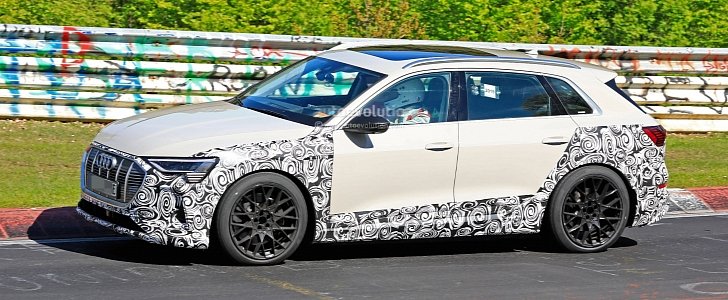Joining the likes of the EQC from Mercedes-Benz and Model X from Tesla, the Audi e-tron has much to prove in the electric crossover segment. For starters, Audi throttled back the deliveries over problems with the supply chain. There’s also the matter of price; at $74,800 for the Standard Plus quattro, customers aren’t queuing up to order the e-tron.
1,791 examples of the breed were sold in Europe in March 2019 compared to 253 in the United States in April. There’s no denying that something doesn’t add up, more so if you put the 75-kWh Model X side by side with the 95-kWh e-tron. Despite the difference in weight, the Tesla manages 255 miles (410 kilometers) while the Audi can’t do better than 204 miles (328 kilometers) of range.
Audi was prepared from the get-go to lose a lot of money on the e-tron, but nevertheless, the four-ringed automaker isn’t admitting defeat. Take a look at the two test mules the carparazzi caught on camera at the Nurburgring, then compare them to the RS lineup of models. Without further beating around the bush, the e-tron prepares to welcome a performance version in 2020.
Larger air intakes to the right and left of the radiator grille, lowered suspension, wider performance tires, different wheels, and a different aerodynamic diffuser at the rear are a few of the more obvious changes. Even more interesting is the fact both test mules feature conventional side mirrors instead of ant antenna-inspired video cameras. Word on the street is Audi could call the model e-tron S instead of e-tron RS.
In addition to better cooling for the braking system, Audi could turn up the electric drive units for better acceleration off the line and on corner exit. Some people suggest Audi could add a third electric motor – one up front and two driving the rear wheels – to level up the output to 640 horsepower. By comparison, the bone-stock model develops 402 horsepower (300 kW) with Boost Technology.
What the four-ringed automaker calls Boost Technology “allows temporary access to additional rated power output when conditions allow and driver initiates the feature.”
Audi was prepared from the get-go to lose a lot of money on the e-tron, but nevertheless, the four-ringed automaker isn’t admitting defeat. Take a look at the two test mules the carparazzi caught on camera at the Nurburgring, then compare them to the RS lineup of models. Without further beating around the bush, the e-tron prepares to welcome a performance version in 2020.
Larger air intakes to the right and left of the radiator grille, lowered suspension, wider performance tires, different wheels, and a different aerodynamic diffuser at the rear are a few of the more obvious changes. Even more interesting is the fact both test mules feature conventional side mirrors instead of ant antenna-inspired video cameras. Word on the street is Audi could call the model e-tron S instead of e-tron RS.
In addition to better cooling for the braking system, Audi could turn up the electric drive units for better acceleration off the line and on corner exit. Some people suggest Audi could add a third electric motor – one up front and two driving the rear wheels – to level up the output to 640 horsepower. By comparison, the bone-stock model develops 402 horsepower (300 kW) with Boost Technology.
What the four-ringed automaker calls Boost Technology “allows temporary access to additional rated power output when conditions allow and driver initiates the feature.”























